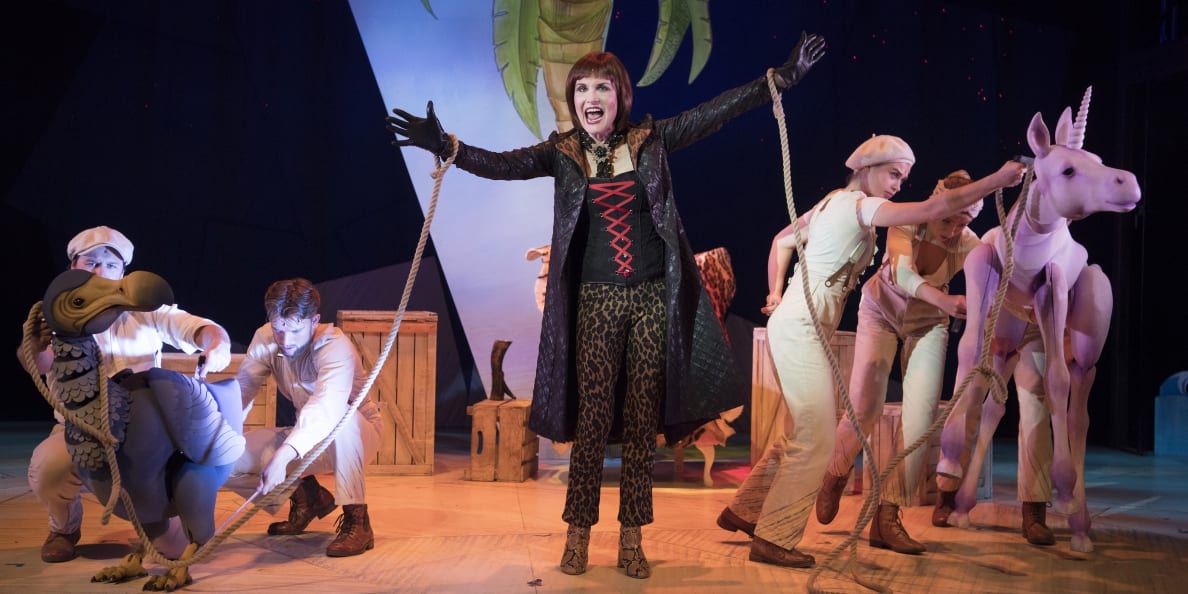There are many things about this production of Doctor Dolittle that are delightful and I was in the company of many children when I saw it, children who clearly enjoyed it even when the more sophisticated ones were also aware of some of its limitations. I personally liked the Brechtian approach to staging it – a kind of compilation of gentle Theatre of Alienation Effects with signs popping up to tell you where you were, and the puppeteers of all the animals dressed in white, completely visible and voicing the various creatures as well as playing their characteristics.
I liked the four-square, brightly-coloured mis-en-scène, the sets and curtain drops. The puppet designs were appealing and clearly evocative of the animals they were supposed to be. And one of the big delights of this show was watching the movements and choreography of the actual puppeteers. There was a lot of pleasure to be had from the sheer energy of the ensemble.
The telling of the Doctor Dolittle adventures was clearly done. The show was lively and the cast were committed. The real problem is that a lot of the material is now very dated but it was handled straight. This show needs jazzing up, it needs to be more of a pantomime or musical hall farrago.
The main problem for me was that the score seems very old-fashioned. It has a few good moments and a couple of good, even memorable, songs; but there is nothing very strong and a lot of it is rather anodyne and feels a bit “paint by numbers”. Two ten-year-old girls that I knew were completely captivated by the presentation; they enjoyed the sheer liveliness of it on stage, and they also came away humming the “Talk to the Animals” song. But they were sophisticated enough to note that the show had a lot of out-of-date elements, and they were particularly annoyed at the treatment of the women in the story. In the year of “Me Too” it seems amazing that the heroine (Emma Fairfax played by Mollie Melia-Redgrave who needs to push her attractive voice somewhat less) gets to be in charge of nothing except preparing meals for the men on the ship. Some of the dialogue truly creaks! And since the original books are set in the earliest part of the Victorian Era, I think that one should wonder if making that more explicit would not have been a good idea.
And so to the main problem. Mark Williams is a very fine actor but he plays it straight. This may be the concept of the director, so I do not blame him, and it is a perfectly valid interpretation. He looks right – indeed he resembles cannily Hugh Lofting’s original illustrations of Doctor Dolittle. But what is needed is someone more like John Barrowman or someone like Matt Slack who will know how to camp it up a bit, deliver some of the more outdated dialogue with irony. The basic premise of the production of the show is visually fine and the concepts of how to present the talking animals and, at the end, the big pink slug, have a kind of continuous charm throughout the evening. I liked the Pushmi-Pullyu (and the co-ordinated puppeteers for that one), the circus sequence, Adele Anderson as the female villains. But that is the problem. All the villains, all the subservient, are women. Patrick Sullivan does well but he is supposed to be a lot dimmer than his sweetheart and yet he is the dominant one. The sensibility of this production is roughly more like the 1950s with no acknowledgement of there having been any changes in our approach to sexual politics in the meantime.
But despite all that, I am sad that the show is closing at the end of its Oxford run and seems to have cancelled quite an extensive tour. It could be very gently titivated to become much more successful and engaging. It seems a waste to lose what is good about this show when a bit of flexible thinking could turn it into something extremely interesting. And even if they kept it as it is, there is still a lot to enjoy, especially if you are a youngster or a grown-up accompanying a youngster.

